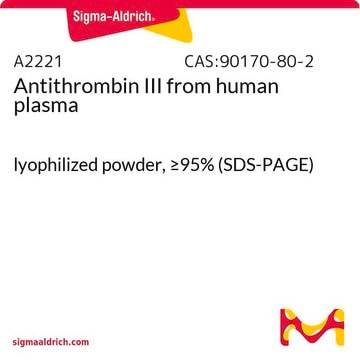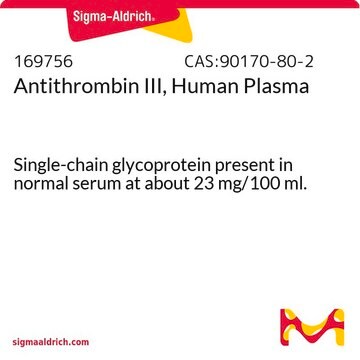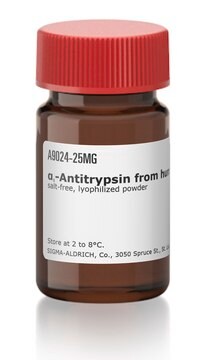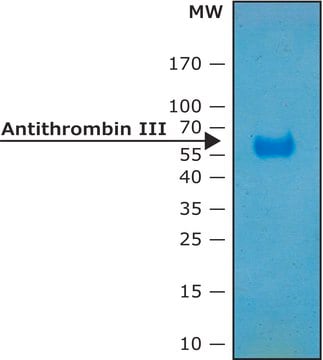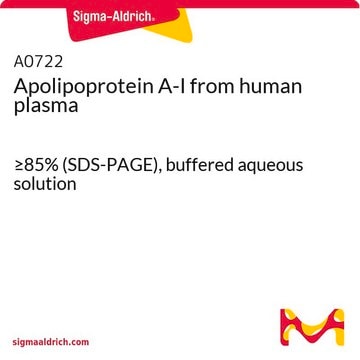SRP6316
Antithrombin III from human plasma
≥95% (SDS-PAGE)
Sinonimo/i:
SERPINC1
Autenticatiper visualizzare i prezzi riservati alla tua organizzazione & contrattuali
About This Item
Codice UNSPSC:
12352202
NACRES:
NA.32
Prodotti consigliati
Origine biologica
human
Saggio
≥95% (SDS-PAGE)
Forma fisica
lyophilized
PM
58 kDa
Confezionamento
pkg of 100 μg
pkg of 500 μg
N° accesso UniProt
Condizioni di spedizione
wet ice
Temperatura di conservazione
−20°C
Informazioni sul gene
human ... SERPINC1(462)
Descrizione generale
SerpinC1, also known as antithrombin III (AT III), is a member of the serpin superfamily of serine protease inhibitors. The gene is mapped to human chromosome 1. SerpinC1 is a glycoprotein with three β-sheets and nine α-helices. The protein has an active site region and a heparin binding site.
Azioni biochim/fisiol
SerpinC1, also known as antithrombin III (AT III), has been found to be a marker for disseminated intravascular coagulation (DIC) and to be of prognostic significance in septic patients. Antithrombin III synthesized in the liver is the principal plasma serpin of blood coagulation proteases and inhibits thrombin and other factors such as Xa by the formation of covalently linked complexes. Thus, it is one of the most important coagulation inhibitors and the fundamental enzyme for the therapeutical action of heparin. The inhibitory activity of AT III undergoes a dramatic increase in the presence of heparin and other glycosaminoglycans. Antithrombin III mediates the promotion of prostaglandin release, an inhibitor of leucocyte activation and downregulation of many proinflammatory cytokines. It exerts anti-inflammatory properties in addition to its anti-coagulative mechanisms. The deficiency or functional abnormality of AT III may result in an increased risk of thromboembolic disease, such as deep vein thrombosis and pulmonary embolism. In addition, it has been reported that AT III can alter or influence inflammatory processes via inhibition of NF (nuclear factor)-κB activation or actin polymerization. It is found in normal serum at 15mg/100mL. Found at higher levels in plasma than in serum because of complexing with thrombin during coagulation. Clinically, reduced levels are indicative of hypercoagulability. Reduction in the levels of antithrombin III enhances the severity of renal ischemia/reperfusion injury.
Stato fisico
Lyophilized from 50 mM Tris-HCl, pH 8.0, with 150 mM NaCl.
Ricostituzione
In water or aqueous buffer
Codice della classe di stoccaggio
13 - Non Combustible Solids
Classe di pericolosità dell'acqua (WGK)
nwg
Certificati d'analisi (COA)
Cerca il Certificati d'analisi (COA) digitando il numero di lotto/batch corrispondente. I numeri di lotto o di batch sono stampati sull'etichetta dei prodotti dopo la parola ‘Lotto’ o ‘Batch’.
Possiedi già questo prodotto?
I documenti relativi ai prodotti acquistati recentemente sono disponibili nell’Archivio dei documenti.
I clienti hanno visto anche
Antithrombin III inhibits nuclear factor kappaB activation in human monocytes and vascular endothelial cells.
Oelschlager C, et al.
Blood, 99, 4015-4020 (2002)
The anti-inflammatory properties of antithrombin III: new therapeutic implications.
Okajima K and Uchiba M
Seminars in Thrombosis and Hemostasis, 24, 27-32 (1998)
Antithrombin III supplementation in severe sepsis: beneficial effects on organ dysfunction.
Inthorn D, et al.
Shock, 8, 328-334 (1997)
Plasma antithrombin III and thrombin generation time: correlation with hemoglobin A1 and fasting serum glucose in young diabetic women.
Sowers JR, et al.
Diabetes Care, 3, 655-658 (1980)
Laboratory tests for antithrombin deficiency.
Khor B and Van Cott EM
American Journal of Hematology, 85, 947-950 (2010)
Il team dei nostri ricercatori vanta grande esperienza in tutte le aree della ricerca quali Life Science, scienza dei materiali, sintesi chimica, cromatografia, discipline analitiche, ecc..
Contatta l'Assistenza Tecnica.